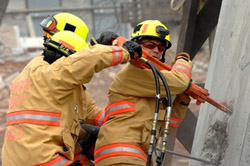Dec 17 2008
Move over, drills, saws, and jackhammers. Now there's something much faster for search-and-rescue missions. And, it just won a technology Best-of-the-Year Award from Popular Science.
 The new Controlled Impact Rescue Tool (CIRT) takes on the old jackhammers like the one seen here, and busts through a 5 1/2-inch slab of steel-reinforced concrete in 13 minutes (vs. 29 minutes for the hammer).
The new Controlled Impact Rescue Tool (CIRT) takes on the old jackhammers like the one seen here, and busts through a 5 1/2-inch slab of steel-reinforced concrete in 13 minutes (vs. 29 minutes for the hammer).
It's the Controlled Impact Rescue Tool (CIRT). And, although it's still in development, a prototype is showing that it can bust through thick concrete walls or barriers in about half the time of traditional methods.
This new concrete-buster can mean all the difference when people are trapped inside collapsed buildings or walls. First responders rushing to get them out, or to deliver lifesaving supplies, must act fast, and this tool does it fast.
Funded by the DHS Science and Technology (S&T) Directorate and developed by Raytheon Company, the CIRT is carried and operated by two people. It uses a blank ammunition cartridge designed for a standard rifle—driving a piston—that, when fired, generates a high-energy jolt. No hoses or cords are required, and it can be loaded to fire as often as two rounds every minute. At 36 inches long and 16 inches in diameter, it weighs all of 105 pounds—light enough to hold up against a wall, yet heavy enough to limit recoil action that can cause injuries.
During a recent test, CIRT went head-to-head against other, traditional rescue methods. It was a race to break through a vertical, 5½-inch slab of steel-reinforced concrete and create a hole 18 inches wide (video clip available). CIRT won with a time of about 13 minutes, compared with 29 minutes or more for the others. Based on similar testing, the tool has also shown that it can bust through a horizontal slab in about 10 to 12 minutes.
"Our initial goal was to reduce the CIRT's breach time to less than 20 minutes," said Jalal Mapar, who manages the project at S&T's Infrastructure and Geophysical Division. "Over the next 12 months, we'll refine the design to make it even more affordable for production. We really believe this is going to be a faster, better, cheaper, and safer technology for the urban search-and-rescue community across the nation."